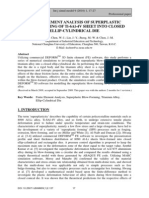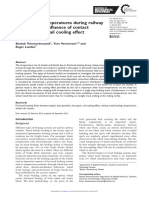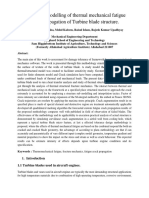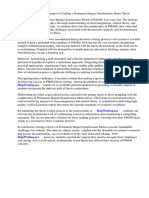0 ratings0% found this document useful (0 votes)
29 viewsWhen Talking About Modeling
When Talking About Modeling
Uploaded by
Muhammad HartonoThis document discusses simulation and what it is. Simulation is imitating the operation of a real-world process over time to observe its behavior without involving the real system. A system model consists of assumptions about how the system operates. Simulation uses these models and assumptions to answer "what if" questions. The document then discusses a specific case study of using finite element analysis to simulate the braking process in automobiles and investigate the thermoelastic instability phenomenon when heat from braking is not dissipated quickly enough. The study compares the maximum temperature and thermoelastic behavior for different materials used for brake disks.
Copyright:
© All Rights Reserved
Available Formats
Download as DOC, PDF, TXT or read online from Scribd
When Talking About Modeling
When Talking About Modeling
Uploaded by
Muhammad Hartono0 ratings0% found this document useful (0 votes)
29 views5 pagesThis document discusses simulation and what it is. Simulation is imitating the operation of a real-world process over time to observe its behavior without involving the real system. A system model consists of assumptions about how the system operates. Simulation uses these models and assumptions to answer "what if" questions. The document then discusses a specific case study of using finite element analysis to simulate the braking process in automobiles and investigate the thermoelastic instability phenomenon when heat from braking is not dissipated quickly enough. The study compares the maximum temperature and thermoelastic behavior for different materials used for brake disks.
Original Description:
kuliah s3
Copyright
© © All Rights Reserved
Available Formats
DOC, PDF, TXT or read online from Scribd
Share this document
Did you find this document useful?
Is this content inappropriate?
This document discusses simulation and what it is. Simulation is imitating the operation of a real-world process over time to observe its behavior without involving the real system. A system model consists of assumptions about how the system operates. Simulation uses these models and assumptions to answer "what if" questions. The document then discusses a specific case study of using finite element analysis to simulate the braking process in automobiles and investigate the thermoelastic instability phenomenon when heat from braking is not dissipated quickly enough. The study compares the maximum temperature and thermoelastic behavior for different materials used for brake disks.
Copyright:
© All Rights Reserved
Available Formats
Download as DOC, PDF, TXT or read online from Scribd
Download as doc, pdf, or txt
0 ratings0% found this document useful (0 votes)
29 views5 pagesWhen Talking About Modeling
When Talking About Modeling
Uploaded by
Muhammad HartonoThis document discusses simulation and what it is. Simulation is imitating the operation of a real-world process over time to observe its behavior without involving the real system. A system model consists of assumptions about how the system operates. Simulation uses these models and assumptions to answer "what if" questions. The document then discusses a specific case study of using finite element analysis to simulate the braking process in automobiles and investigate the thermoelastic instability phenomenon when heat from braking is not dissipated quickly enough. The study compares the maximum temperature and thermoelastic behavior for different materials used for brake disks.
Copyright:
© All Rights Reserved
Available Formats
Download as DOC, PDF, TXT or read online from Scribd
Download as doc, pdf, or txt
You are on page 1of 5
When talking about modeling
It is natural to talk about simulation
What is Simulation?
Simulation is the imitation of the operation of a real-world
process or systems over time.
The objective is
To generate a history of the model and the observation of that
history helps us understand how the real-world system works,
not necessarily involving the real-world into this process.
A system (or process) model takes the form of a set of
assumptions concerning its operation.
In a model mathematical and logical assumptions are
considered, and entities and their relationship are delimited.
The objective of a model and its respective simulation is to
answer a vast number of what-if questions.
Braking Process in Automobiles: Investigation
of the Thermoelastic Instability Phenomenon
M. Eltoukhy and S. Asfour
Department of Industrial Engineering, College of Engineering, University of Miami
USA
Vehicles Movement
nput
output
waste
!reaking "sub system# nput "$$$# %utput "$$$#
&aste"$$$#
During the braking action
The kinetic energy produced at the wheel is transformed into heat
energy,
If it doesnt dissipate fast enough into the air stream from the brake to the brake
disk.
Thermal judder vibrations transferred through the chassis during braking), which is a result of
non!uniform contact cycles between the pad and the disk brake rotor, which is primarily an
e"ect of the locali#ed Thermo!Elastic Instabilities TEI$ at the disk brake rotor surface.
As a result, the thermal conducti%ity plays a critical role in handling such heat generated
A case study regarding a transient analysis of the thermoelastic contact problem for disk
brakes with frictional heat generation
&erformed using the 'nite element analysis
(EA$ method
)e will know*
The in+uence of the material properties on the thermoelastic beha%ior, represented by
the ma,imum temperature on the contact surface is compared among di"erent types of
brake disk materials,
such as grey cast iron grey iron grade -./,
high!carbon grade iron,
titanium alloyed grey iron,
and compact graphite iron 01I$$,
Aluminum metal matri, composites Al!MM0s$,
0eramic brakes, Al-23 Al!MM0 and Si0 Al!MM0
Braking process
"Breaking sub system#
Vehicles Dynamics
Constant deceleration
'ssumptions $$$$$$
(.
).
*.
+.
,atigue analysis and life prediction of bridges with
structural health monitoring data
You might also like
- 10.1007@s11668 020 00831 yDocument32 pages10.1007@s11668 020 00831 yThe Three FattyNo ratings yet
- Correlation of Structure Functions Between Analytical/Simulation Model and T3Ster Testing Using FloEFDDocument13 pagesCorrelation of Structure Functions Between Analytical/Simulation Model and T3Ster Testing Using FloEFDberker_yurtsevenNo ratings yet
- Safety Factor and Fatigue Life - Effective Design Measures-V01Document14 pagesSafety Factor and Fatigue Life - Effective Design Measures-V01tritienNo ratings yet
- CAD - Model of DiscDocument5 pagesCAD - Model of DiscAshokkumar VelloreNo ratings yet
- Thermal Deformation Analysis of Automotive Disc Brake SquealDocument26 pagesThermal Deformation Analysis of Automotive Disc Brake SquealNg Guo LiangNo ratings yet
- Numerical Simulation of The Stress, Temperature & Wear Behaviours of The Drum BrakeDocument12 pagesNumerical Simulation of The Stress, Temperature & Wear Behaviours of The Drum BrakepashaNo ratings yet
- An Investigation of Disc Brake Rotor Using FeaDocument12 pagesAn Investigation of Disc Brake Rotor Using Fearudey18No ratings yet
- Thermodynamics and The Simulation EngineerDocument43 pagesThermodynamics and The Simulation EngineerNeagu Mihaela100% (1)
- Study of Thermal Analysis of Disc Brake Rotor For Different DISC BrakesDocument9 pagesStudy of Thermal Analysis of Disc Brake Rotor For Different DISC Brakes刘牛No ratings yet
- Dymenic DesignDocument15 pagesDymenic DesignBipin PatelNo ratings yet
- YEVTUSHENKO (2010) The Fem-Modeling of The Frictional Heating Phenomenon in The Pad-Disc Tribosystem - A ReviewDocument21 pagesYEVTUSHENKO (2010) The Fem-Modeling of The Frictional Heating Phenomenon in The Pad-Disc Tribosystem - A Reviewgustavo5150100% (1)
- 7206 9292 1 PB PDFDocument11 pages7206 9292 1 PB PDFMichael SerraNo ratings yet
- Numerical Modeling of Disc Brake System in Frictional Contact PDFDocument18 pagesNumerical Modeling of Disc Brake System in Frictional Contact PDFnatuan74No ratings yet
- Ali Belhocine, Mostefa Bouchetara: Archive OF Mechanical Engineering Vol. Lxi 2014 Number 1 10.2478/meceng-2014-0005Document25 pagesAli Belhocine, Mostefa Bouchetara: Archive OF Mechanical Engineering Vol. Lxi 2014 Number 1 10.2478/meceng-2014-0005Abhinav BowlayNo ratings yet
- Design and Analysis of Single Plate ClutchDocument3 pagesDesign and Analysis of Single Plate ClutchChandra Sekar100% (1)
- Thermomechanical Behaviour of Dry Contacts in DiscDocument15 pagesThermomechanical Behaviour of Dry Contacts in DiscEzz eldeen AymanNo ratings yet
- A Study Into Crack Growth in A Railway Wheel Under Thermal Stop Brake Loading SpectrumDocument11 pagesA Study Into Crack Growth in A Railway Wheel Under Thermal Stop Brake Loading SpectrumRavi Kiran MeesalaNo ratings yet
- A Thermomechanical Model For The AnalysiDocument15 pagesA Thermomechanical Model For The Analysipinakanajagadeeshkumar369No ratings yet
- TRICK and ThermoRIDE Conjunct Use For Tires Optimal Working Range IdentificationDocument7 pagesTRICK and ThermoRIDE Conjunct Use For Tires Optimal Working Range IdentificationMr. PashaNo ratings yet
- Modeling Material ScienceDocument11 pagesModeling Material Sciencedgs_uspNo ratings yet
- Turbine Blade Life Time Estimation Considering The EffectDocument15 pagesTurbine Blade Life Time Estimation Considering The EffectSudhanshu Balodi100% (1)
- Clutch Assembly Modeling and Dynamic Analysis: Gowtham ModepalliDocument6 pagesClutch Assembly Modeling and Dynamic Analysis: Gowtham ModepalliLại Thế KhánhNo ratings yet
- Transient Thermal Analysis of An Induction Motor - COBEM 2005Document8 pagesTransient Thermal Analysis of An Induction Motor - COBEM 2005keepmoshing2No ratings yet
- Kostyantyn Holenko - DykhaDocument10 pagesKostyantyn Holenko - DykhaKostyantyn GolenkoNo ratings yet
- Materials Science and TechnologyDocument27 pagesMaterials Science and TechnologyzainyousafzaiNo ratings yet
- UpdatedDocument4 pagesUpdatedMuhammad Azhar SaeedNo ratings yet
- Using Finite Element Analysis For Continued Product ImprovementDocument3 pagesUsing Finite Element Analysis For Continued Product ImprovementPannkaaj MoreNo ratings yet
- Finite Element Analysis of Superplastic Blow-Forming of Ti-6Al-4V Sheet Into Closed Ellip-Cylindrical DieDocument0 pagesFinite Element Analysis of Superplastic Blow-Forming of Ti-6Al-4V Sheet Into Closed Ellip-Cylindrical DieAlagu EswaranNo ratings yet
- A Numerical Study On Effects of Friction-Induced Thermal Load For Rail Under Varied Wheel Slip ConditionsDocument12 pagesA Numerical Study On Effects of Friction-Induced Thermal Load For Rail Under Varied Wheel Slip ConditionsRavi Kiran MeesalaNo ratings yet
- Modelling of Temperatures During Railway Tread Braking: Influence of Contact Conditions and Rail Cooling EffectDocument17 pagesModelling of Temperatures During Railway Tread Braking: Influence of Contact Conditions and Rail Cooling EffectManjunath AithalNo ratings yet
- Document RAJUDocument4 pagesDocument RAJUKamal OrugantiNo ratings yet
- Model of Friction Wear and ContactDocument10 pagesModel of Friction Wear and Contactadriano_rodsNo ratings yet
- Finite ElementDocument12 pagesFinite ElementsreeNo ratings yet
- Experimental Studies of The Thermal Management SysDocument9 pagesExperimental Studies of The Thermal Management Sysflorin chisNo ratings yet
- FEA Simulation of Metal CuttingDocument6 pagesFEA Simulation of Metal CuttingAnonymous p8bHAAxNo ratings yet
- Numerical Simulation of Friction Stir WeldingDocument6 pagesNumerical Simulation of Friction Stir WeldingJitender KunduNo ratings yet
- An InvestigationDocument8 pagesAn InvestigationBintang SuryoNo ratings yet
- Litrature ReviewDocument5 pagesLitrature Reviewsanthosh sivaNo ratings yet
- Thermal Analysis of Both Ventilated and Full Disc Brake RotorsDocument20 pagesThermal Analysis of Both Ventilated and Full Disc Brake RotorsAL Rajhi ZakariaNo ratings yet
- Analysis & Modelling of Thermal Mechanical Fatigue Crack Propagation of Turbine Blade StructureDocument21 pagesAnalysis & Modelling of Thermal Mechanical Fatigue Crack Propagation of Turbine Blade StructureSheetalNo ratings yet
- Simulation of Engagement Control in Automotive Dry-Clutch and Temperature Field Analysis Through Finite Element ModelDocument9 pagesSimulation of Engagement Control in Automotive Dry-Clutch and Temperature Field Analysis Through Finite Element ModelAlireza HassaniNo ratings yet
- Tribology in Industry: A. Belhocine, A.R. Abu Bakar, M. BouchetaraDocument18 pagesTribology in Industry: A. Belhocine, A.R. Abu Bakar, M. BouchetaraRizki Eka PutraNo ratings yet
- Deform PaperDocument14 pagesDeform PaperSample RajNo ratings yet
- kiembennnhietdiaphanhtaDocument5 pageskiembennnhietdiaphanhtaManh NguyenNo ratings yet
- Fischer2019 Article Microstructure-basedModellingO PDFDocument14 pagesFischer2019 Article Microstructure-basedModellingO PDFMarco DeluciaNo ratings yet
- Ijte 05 01 005Document11 pagesIjte 05 01 005toancaocapa31No ratings yet
- JMMP 02 00063Document19 pagesJMMP 02 00063kishoreNo ratings yet
- Permanent Magnet Synchronous Motor ThesisDocument4 pagesPermanent Magnet Synchronous Motor Thesisubkciwwff100% (2)
- 1 s2.0 S2214785321005289 MainDocument8 pages1 s2.0 S2214785321005289 Mainsachinphalswal19No ratings yet
- Thermal Analysis of Brake Disc of An AutomobileDocument15 pagesThermal Analysis of Brake Disc of An Automobilenitin thoratNo ratings yet
- A Recursive Wheel Wear and Vehicle Dynamic Performance Evolution Computational Model For Rail Vehicles With Tread BrakesDocument28 pagesA Recursive Wheel Wear and Vehicle Dynamic Performance Evolution Computational Model For Rail Vehicles With Tread BrakesBonny SidhuNo ratings yet
- Systematical Review On The Numerical Simulations of Laser Powder Bed Additive Manufacturing (#1013501) - 2041522Document18 pagesSystematical Review On The Numerical Simulations of Laser Powder Bed Additive Manufacturing (#1013501) - 2041522LeoNo ratings yet
- Inside Discrete-Event Simulation Software: How It Works and Why It MattersDocument15 pagesInside Discrete-Event Simulation Software: How It Works and Why It MattersDejan DraganNo ratings yet
- Torsional Vibration Analysis of Synchronous Motor Driven TCDocument16 pagesTorsional Vibration Analysis of Synchronous Motor Driven TCBharath Chandra ReddyNo ratings yet
- Jmert SPD d117Document8 pagesJmert SPD d117Atul SaxenaNo ratings yet
- Sae Technical Paper Series: Daniel ThuressonDocument13 pagesSae Technical Paper Series: Daniel ThuressonVinith KumarNo ratings yet
- Advances in Motion Sensing and Control for Robotic Applications: Selected Papers from the Symposium on Mechatronics, Robotics, and Control (SMRC’18)- CSME International Congress 2018, May 27-30, 2018 Toronto, CanadaFrom EverandAdvances in Motion Sensing and Control for Robotic Applications: Selected Papers from the Symposium on Mechatronics, Robotics, and Control (SMRC’18)- CSME International Congress 2018, May 27-30, 2018 Toronto, CanadaFarrokh Janabi-SharifiNo ratings yet



























































